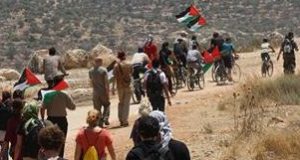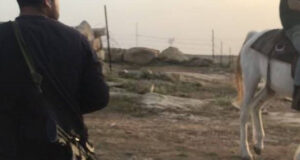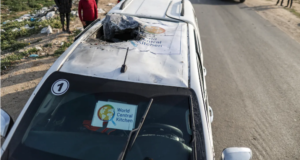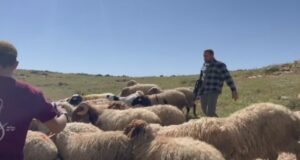By James Bennet
Originally published in the New York Times
West Bank – The barrier Israel is building against West Bank Palestinians has had a striking, if unintended, effect: It has stirred a sustained, bloodless protest movement among Palestinians for the first time in more than three years of conflict.
As the bulldozers have swept south toward Jerusalem and cut deeper into West Bank land, villagers who have mostly stayed on the sidelines of the uprising have joined with Israeli leftists to demonstrate. In places, as in this hamlet, they have blocked the machines with their bodies.
“I am totally against touching civilians,” said Naim Morar, 50, a leader of the movement here, as he walked hand in hand on Friday with his 5-year-old son, Mashal, for another demonstration along the 50-yard-wide gash the construction has opened through the village fields.
To that statement of principle, he added a more pragmatic consideration: “If there was shooting at the wall, it would have been finished the next day. But our peaceful resistance forced them to stop.” Often, teenagers throw stones at the end of the demonstrations, but the organizers say they discourage that.
This new approach raises a basic, discomfiting question: Why should such tactics seem unusual? Why has the Palestinian national movement become defined instead by increasingly nihilistic violence, like the suicide bombing on a Jerusalem bus last Sunday that killed eight passengers?
It is to stop such suicide attacks that Israel says it needs to build this barrier. Palestinians say it is actually a land grab.
The answer to the question about tactics shines a light into several corners of the conflict, including the jihadic visions of militant Islam, the strategy of anti-colonial movements of the 20th century, the structure of Palestinian society and the nature of the Israeli occupation.
One also must not ignore the appetites of the news media. It is not as though the Palestinians just discovered the existence of peaceful tactics. Some Palestinians complain that sporadic strikes and marches get little international attention.
As the protest unfolded here – with hundreds chanting as they faced off with about 20 Israeli soldiers and policemen at the construction site – demonstrators at the next village, Qibiya, began throwing stones. Then from the Israeli side came the inevitable booms, and the telltale gray trails of tear-gas canisters streaked toward the protesters. Most of the handful of news photographers covering this rally hurried toward that scene, a quarter-mile away.
On Thursday, in a similar anti-barrier demonstration in the village of Biddo, Israeli forces responded to stone throwers with deadly fire, killing two Palestinians.
In advocating civil disobedience, Gandhi and Martin Luther King Jr. had a bedrock faith in the essential humanity of their oppressors. As this conflict grinds on, it is tempting to conclude that any chance of glimpsing a shared humanity has been blown away.
Yet demonstrations like the one here suggest that is not necessarily so. On her way to the protest, an elderly Palestinian woman in a white head scarf paused atop a heap of rocks and reached back to help a gray-haired Israeli woman. They cleared the obstacle, then kept holding hands as they walked toward the crowd.
The Palestinians have never had a mainstream leader committed to nonviolent tactics, despite their official acceptance of Israel’s right to exist.
“The predominant paradigm was that this is a war of liberation,” said Martin Kramer, an expert on Islam and Arab politics. “Their model was Algeria. It was armed struggle against a colonial power, and you had to bleed them.”
Under American pressure last year, Yasir Arafat appointed Mahmoud Abbas, an opponent of the armed uprising, as his prime minister.
Last April, as Mr. Abbas was confirmed by the Palestinian parliament, one legislator, Abdel Jawad Saleh, said Mr. Abbas was making a mistake in trying to end the uprising without offering an alternative form of resistance. “You should be a Gandhi,” Mr. Saleh told him. No Gandhi, Mr. Abbas lasted less than five months in the job.
The main political competition for Mr. Arafat’s mainstream Fatah faction is even sharper-edged – the fundamentalist groups Hamas and Islamic Jihad, which remain officially bent on erasing Israel.
With no one in power exhorting them to try other tactics, Fatah militants, in theory members of a secular faction, have tried to out-Hamas Hamas. They adopted an Islamic name for their violent wing, the Al Aksa Martyrs Brigades, and took up suicide bombing along with the language of martyrdom.
Mirroring a widespread Israeli opinion of Palestinians, most Palestinians take it as axiomatic that Israelis respond to nothing but force. “They have ample precedent to cite,” Dr. Kramer said.
It is not lost on Palestinians that, during the relatively quiet days under the Oslo peace accords between the two Palestinian uprisings, Israeli settlements in the occupied territories doubled in size. Further, it was to the neighboring village, Qibiya, in 1953 that a young commando named Ariel Sharon led a reprisal raid for the killing of an Israeli woman and her two toddlers. Mr. Sharon later said that he and his men believed that the 45 houses they blew up were empty.
But 69 Arabs were killed, half of them women and children. People here are accustomed to the trading of an eye for an eye.
Yet there are reasons to understand why peaceful protest could catch hold in these villages and also why it may not spread far beyond them. When Mr. Sharon raided Qibiya, it was controlled by Jordan. Now, Israeli forces can move freely here. That is a practical reason for peaceful protest: any militant would be quickly arrested or killed. Palestinian gunmen have largely retreated to the city centers and refugee camps, where they can hide more easily.
Villagers in this area of the West Bank, within sight of the towers of Tel Aviv, are rather accustomed to Israelis. Many have worked in Israel and speak Hebrew. Forming alliances with left-wing Israelis – even the young people who show up to demonstrate with multiple piercings in ears, nose and lips – does not seem as outlandish as it does to Palestinians who have known only Israeli soldiers or settlers. Then there is the barrier itself. It is consuming the fields and orchards of many farming families without a history of militancy, driving them to protest. It is cutting Palestinian workers off from Israeli jobs. Further, as Palestinians have taken to calling it the “apartheid wall” and foreign activists have focused their attention on it, it has emerged as a tangible, telegenic object of mass protest.
The path of the barrier, which looks like a dirt runway through the West Bank, halted in the middle of an olive orchard here in early January, after peaceful demonstrations to block the bulldozers.
Days later, Naim Morar and his brother, Ayed, were separately arrested by Israeli forces in what was seen here as an effort to break the demonstrations. In each case, an Israeli judge ordered the man’s release, saying there was no evidence of ties to terrorism. “I felt that the mere reason for the arrest pertained to the anti-fence protest and nothing beyond that,” wrote the judge in his order releasing Naim Morar.
Ayed Morar, 42, has a shiny, puckered scar on his left bicep from a bullet wound in the first intifada. He was throwing stones, he said. “In my life, I experienced a lot of ways to struggle,” he said. “But we are not against the Israelis, and we are not against the Jews. We are just against occupation. We have the right to struggle, but we have to choose the best way.” He added that Palestinians were being seen as terrorists around the world, and that “we need international governments to be with us.”
That sounds more like a pragmatic argument than a clarion call for nonviolence. Rather than pointing to a break with the past, these demonstrations increasingly offer a return to it – to the first intifada, when protesters and stone-throwing youths stood up to heavily armed soldiers. That David-and-Goliath imagery gained the Palestinians sympathy worldwide.
As the demonstrators left the construction site and climbed the hill toward the village Friday, a few teenagers ineffectually flung stones toward the soldiers. The soldiers responded with tear gas, sending everyone off with watering eyes and stinging throats.
“The first intifada was more popular because of the stones,” said Sanad Shahadi, 18, holding a sling fashioned from rope and a nylon strap.
Asked if the violence conflicted with the demonstration, he said: “It’s a symbol. If you throw a stone at a soldier, you won’t kill him. It’s a message against occupation, not a message to kill.”
 International Solidarity Movement Nonviolence. Justice. Freedom.
International Solidarity Movement Nonviolence. Justice. Freedom.



